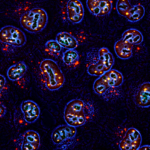Link to Pubmed [PMID] – 10788439
J. Biol. Chem. 2000 May;275(18):13321-9
The ubiquitin-related SUMO-1 molecule has been shown recently to modify covalently a number of cellular proteins including IkappaBalpha. SUMO-1 modification was found to antagonize IkappaBalpha ubiquitination and protect it from degradation. Here we identify the transcription factors c-Jun and p53, two well known targets of ubiquitin, as new substrates for SUMO-1 both in vitro and in vivo. In contrast to ubiquitin, SUMO-1 preferentially targets a single lysine residue in c-Jun (Lys-229), and the abrogation of SUMO-1 modification does not compromise its ubiquitination. Activation of Jun NH(2)-terminal kinases, which induces a reduction in c-Jun ubiquitination, similarly decreases SUMO-1 modification. Accordingly, loss of the two major Jun NH(2)-terminal kinase phosphorylation sites in c-Jun, Ser-63 and Ser-73, greatly enhances conjugation by SUMO-1. A SUMO-1- deficient c-JunK229R mutant shows an increased transactivation potential on an AP-1-containing promoter compared with wild-type c-Jun, suggesting that SUMO-1 negatively regulates c-Jun activity. As with c-Jun, SUMO-1 modification of p53 is abrogated by phosphorylation but remains unaltered upon chemical damage to DNA or Mdm2-mediated ubiquitination. The SUMO-1 attachment site in p53 (Lys-386) resides within a region known to regulate the DNA binding activity of the protein. A p53 mutant, defective for SUMO-1 conjugation, shows unaltered ubiquitination but has a slightly impaired apoptotic activity, indicating that modification by SUMO-1 might be important for the full biological activity of p53. Taken together, these data provide a first link between the SUMO-1 conjugation pathway and the regulation of transcription factors.

